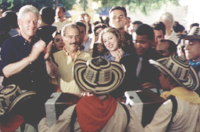- Sombrero Vueltiao
-
Culture of
Colombia
Art
Cinema
Cuisine
Dance
Folklore
Literature
Music
Radio & Television
Sports
TheaterThe sombrero vueltiao or sombrero vueltiado (Colombian Spanish for hat with laps) is a traditional hat from Colombia and one of its symbols. It is made out of Gynerium sagittatum known locally as caña flecha, a type of cane that grows in the region. The word vueltiao is a Colombian regionalism from the northern Caribbean Region and the area surrounding the Magdalena River basin that originates in the word for "lap" (Spanish:vuelta), and arose due to the way the hat is made. Vueltiao is correctly spelled volteado; however, the altered spelling reflects the actual pronunciation. The quality of the hat is determined by the number of "laps" used and its bending flexibility. The more flexible the hat is, the higher quality it is.
The making of the hat originated amongst the Zenú tribes of Colombia. The Colombian delegation to the 2004 Olympics wore the vueltiao during the opening ceremony. It is also traditionally worn by cumbia dancers and vallenato artists.
Contents
Making a Sombrero Vueltiao
Making a sombrero vueltiao is a lengthy process. First, the caña flecha leaves must be dried and the veins removed using a knife and a piece of leather to obtain uniform, sturdy strips. The strips are then dried in the sun until they turn from green to beige or white, and are sorted according to color. The beige, or "dirty strips" (Spanish:sucias) are then soaked in sand-free black mud. After about three or four days in the mud, the colored strips are washed thoroughly with cold water and boiled in vija, another wild plant, for at least a couple of hours. After this, the tinted strips are again dried in the sun for several days, and the coloring process is repeated until they have reached a uniform black color.
After the desired colors are obtained, the caña flecha strips are woven into the braids that are used to form the sombrero. This can take many days, depending on the desired quality. The olma, or central part of the top of the hat, is the first part of the hat to be woven. The crown of the hat and later the wings are made. Once the manual part of constructing the hat is finished, the hat is completed by using a foot-driven sewing machine to sew the hat together.
Types of Sombreros
The Quinciano is the most commercially available Sombrero Vueltiao and also the cheapest. These hats are made in just three days, are loosely woven together, and only use fifteen pairs of caña flecha strips to make the weave.
The Diecinueve, as the name suggests, uses nineteen pairs of caña flecha strips to produce a finer braid that will result in a softer and finer sombrero. They can take up to a week to produce by hand.
The Veintiuno uses twenty-one pairs of caña flecha strands per weave and is finer than the Quinciano and the Diecinueve. These hats are usually custom-made to order and take ten to fifteen days to produce by hand.
The Veintitres is made of twenty-three pairs of caña flecha strips. The Veintitres, like the Veintiuno, is very fine and notably softer and lighter than its predecessors. It takes from twelve to twenty days to make this sombrero from scratch..
The Veintisiete are the finest sombreros available and use twenty-seven pairs of caña flecha. They can be folded up and put in a pocket without being damaged. The weave is very dense, and is soft to the touch. The Veintisiete is the most expensive sombrero vueltiao and can take up to a month to produce by hand.
National Symbol of Colombia
 US President Bill Clinton and daughter Chelsea during a visit to Cartagena, Colombia, where they were greeted by a Vallenato music children group.
US President Bill Clinton and daughter Chelsea during a visit to Cartagena, Colombia, where they were greeted by a Vallenato music children group.
The sombrero vueltiao is no longer just for Colombian peasants, as its popularity has sharply risen. The increase in demand has also increased the price, such that the original farmers can no longer afford some of the finer hats. The sombrero has also become an admired and appreciated work of art appreciated both by Colombians and foreigners.
Most of these handmade hats are produced by entire Zenú families located in the Departments of Cordoba and Sucre.
This iconic symbol of Colombia has been sported by hundreds of personalities, including Pope John Paul II when he visited Colombia in 1986, and former President of the United States Bill Clinton when he visited Cartagena, Colombia in August 2000.
References
 National symbols of Colombia
National symbols of ColombiaNational Anthem · Flag · Coat of Arms · Sombrero Vueltiao · Andean Condor · Carriel · Poporo Quimbaya · Wax Palm · May flower Orchid · Chiva Bus
Categories:- National symbols of Colombia
- Colombian clothing
- Hats
- Colombian handicrafts
Wikimedia Foundation. 2010.


